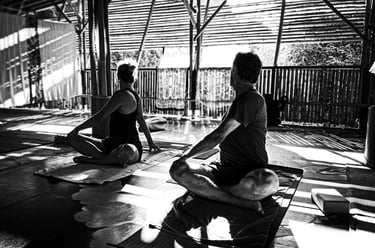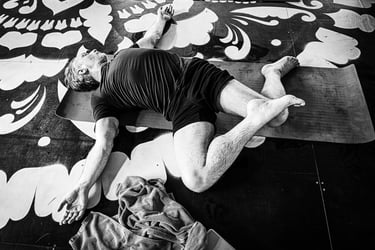Twisting Poses in Yoga


You can practise twists in a variety of positions- reclining, seated, or standing.
When sitting, engaging the abdominal muscles and pelvic floor stabilises the pelvis, which supports the lower back. A grounded pelvis allows the spine to lengthen as the core muscles work to support the twist.
As you twist, there’s also a gentle internal massage of the abdominal organs, such as the liver, kidneys and glands in that area. This helps improve digestive health, supports blood sugar management and aids in detoxification.


Twists are a common part of most yoga practices. Essentially, a twist involves rotating the torso, which shifts the relationship of each vertebra through the combined action of several muscles.
Twists help stretch and strengthen the muscles and connective tissues around the spine, improving the back’s range of motion. With regular practice, they can reduce the risk of back pain, improve posture, and help prevent injuries. Twists also stimulate the abdominal organs, benefiting digestion.
In reclining twists, the upper body stays stable while the lower spine does most of the twisting. The hips and legs rotate, while the torso remains steady, and the shoulders stay grounded.
In seated and standing twists, alignment is key. Once you've grounded and lengthened, it's important to engage the abdominal muscles and pelvic floor. This helps stabilise the pelvis and support the lower back. In seated poses, the pelvis stays rooted as the spine lifts upwards. In standing poses, the spine moves forward as the pelvis remains steady. Proper alignment ensures a safe, effective twist.
More specifically:
Liver - detoxification, metabolism;
Kidneys - filtration, waste removal
Adrenal glands - stress response, metabolism;
Pancreas - blood sugar regulation;
Spleen - immune function, detoxification;
Stomach - digestive health;
The increased blood flow to these organs promotes overall wellness and can have a balancing effect on metabolism.
It's best to approach the twist as a gentle, gradual movement that builds strength by engaging the muscles without any jerky motions.
Moving slowly and mindfully into the final twist can be both physically and mentally challenging - especially after a long day at work - but it’s a great way to release tension and restore balance.
As you explore the physical and energetic benefits of twists, you may begin to notice subtle shifts in your body - whether it's the gentle massage of your abdomen the release of tension or how your breath flows differently in each twist.
This heightened sensitivity to your body's internal landscape is a key aspect of interoception, the awareness of internal bodily sensations.
By refining this awareness, you deepen your connection to your body's signals, enhancing both your yoga practice and your overall well-being.
More Insights
